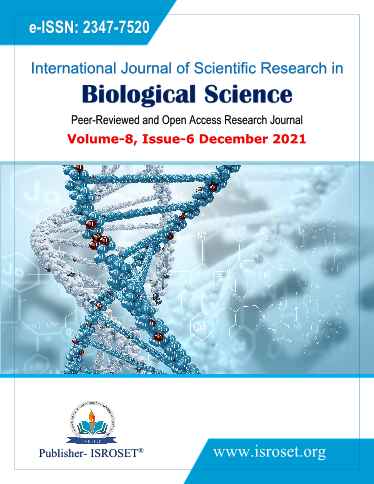Mosquitoes and their perceived nuisance in Tripoli
Keywords:
Mosquito, nuisance, bite, Protective measuresAbstract
Despite the high numbers of mosquitoes observed in some areas, little is known about the biting nuisance of mosquitoes in Libya. Tripoli municipality is a place notorious for nuisance mosquitoes perceived in year 2015, The objective was to assess the impact of mosquito nuisance on the residents of Tripoli municipality and to show results of mosquitoes collected during the nuisance outbreak. Two hundred people were randomly selected and asked if they had been bitten by mosquitos. If they said yes, they were asked to explain where and when they were attacked by mosquitos, as well as what precautions they took to avoid mosquito bites. The questionnaire was filled out by 160 participates. 65% of those reported being bitten by mosquitoes, with most bites occurring outdoors during the summer. Thirty-nine percent said most of the biting happened in the evenings and at night. 43 (27%) took protective measures against being bitten. Of those respondents who protected themselves against biting using repellents (44%), with the remainder changing their behavior to avoid mosquitoes, including closing or screening windows and windows or doors screen with (35%), (2%) respectively, wearing thicker clothes (4%) and spraying insecticide (21%).one person stayed inside (2.3%). Mosquitoes are a major issue for a large section of Tripoli`s population, according to this study. Given the growing worry about the threat posed by potential and emerging viruses in Libya, health officials need to make major efforts to alert the public about the threats posed by mosquitoes in areas where they are common.
References
X. Bonnefoy, H. Kampen & K. Sweeney,”Public health significance of urban pests”, WHO Regional Office for Europe Publisher; Denmark, pp. 347 – 387, 2008.
G. Ragazzi,” La malaria a Touarga”. Arch. Ital. Sci. Med. Colon, Vol.3, Issue. 14, pp. 264 – 276, 1933
E. Zavattari. “Prodromo della fauna Della Libia”. Tipografia già cooperativa, Vol.2, Issue. 7, pp. 726 – 730, 1934.
A. ANON. “Bollettino delle malattie infettive verificatesi Nei Mesi de Gennaio a dicembre” Bolletino Sanitario Della Tripolitania; Tripoli. Vol.2, Issue.1 Vol 2, pp. 1- 12, 1944 -1950
A. ANON, “Malaria in Libya”. Health Torch, Vol. 2, Issue 2, pp. 1–9.1957
J.W. Goodwin &A.B. Paltrinier. “Oasis malaria in Libya”. Mimeographed technical document EM/ME 2/8. World Health Organization, Geneva. Vol. 4, Issue.3, pp. 6–11. 1959
J.W. Goodwin, “A list of the mosquitoes of Libya”. Mosquito News, 21, pp. 106-109, 1961
A. Shalaby, “Survey of the mosquito fauna of Fezzan South-Western Libya”. Bulletin of theEntomological Society of Egypt, Vol.5 Issue. 6, pp. 301-312, 1972.
W. Macdonald. “Anophelines of Libya and their control”. Gariounis Med J, Vol. 2, Issue. 5, pp. 72-74, 1982
A. Gebreel. “Malaria in Libya: introduction and historical review”. Garyounis Med. J, Vol.4, Issue.5, pp. 70-71,1982
A. Gebreel, H.Gilles &J. Prescott. “Studies on the sero-epidemiology of endemic diseases in Libya”, IV Malaria. Annals of Tropical Medicine & Parasitology, Vol.7, Issue.9, pp. 341-347. 1985
C. Ramsdale. “Anopheles mosquitoes and imported malaria in Libya”. Mosquito Systematics, Vol.2 Issue. 2, pp. 34-40.1990
S. Manguin, P.Carnevale, J. Mouchet, M. Coosemans, J. Julvez, D. Richard-Lenoble, J. Sircoulon, “Biodiversity of malaria in the world”, John Libbey Eurotext Publisher; Paris, pp. 20- 40, 2008
H. Aqeehal, H. Abuabaid, W. Saadawi, & B. Annajar. “Molecular characterization of mosquito in eastern Tripoli, Libya for species Culex pipiens, molestus and hybrids”. International Journal of Mosquito Research Vol 6. Issue 6; pp. 26-30. 2019.
H. Aqeehal, N.Shibani, B.Annajar. “Mosquito species composition at a selected area in eastern Tripoli, Libya”. International Journal of Entomology Research, Vol.6, Issue.4, pp. 122-125. 2019.
D. Roiz, S.Ruiz, R. Sorigue & J. Figuerol. “Climatic effects on mosquito abundance in Mediterranean wetlands”. Parasites & vectors, Vol.7, Issue.1, pp.1-13.2014.
H. Aqeehal, “Mosquito nuisance Report: a public health issue posed by mosquitoes” (unpublished report). National Center for Diseases Control –Libya, pp. 1-10, 2016.
D. Becker, M. Petric, C.Zgomba, M. Boase, C. Madoon, A. Dahi, and A. Kaiser. “Mosquitoes and their Control”, 2nd ed. Springer Verlag, Berlin/Heidelberg Publisher, Germany, pp.54 -55, 2010.
S. Bogojevic, E.Merdic & T. Bogdanovic.” The flight distances of floodwater mosquitoes (Aedes vexans, Ochlerotatus sticticus and Ochlerotatus caspius) in Osijek, Eastern Croatia”. Biologia, Vol. 66, Issue. 4, pp. 678-683, 2011.
E. Blomgreni,C. Hesson,L.Schafer & O. Lunndstrom. “Pest occurrence of Aedes rossicus close to the Arctic Circle in northern Sweden”. Journal of Vector Ecology, Vol.43, Issue.1, pp. 36-43, 2018.
S. Gupt, S.Jain, S.Chaudhry &K. Agrwal. “Role of insects as inhalant allergens in bronchial asthma with special reference to the clinical characteristics of patients”. Clinical and Experimental Allergy, Vol 2 Issue.2, pp. 519–524.1990.
P. Galindo, E.Gomez, J.Borja, F,R. Garcia, M. Lombardero & D. Barber.”Mosquito bite hypersensitivity”. Allergologia et Immunopathologia (Madrid) Vol.2, Issue. 6, pp. 251–254,1998.
S. Hassoun, M. Drort &A.Sabbah. “Anaphylaxis caused by a mosquito: 2 case reports”. Allergie et Immunologie Paris, Vol.3, Issue. 1, pp. 285–287.1999
N. Shahhosseini,J. Friedrich, H. Moosa-Kazemi, M. Sedaghat, H.Kayedi, H.Tannich, &R. Luhken . “Host-feeding patterns of Culex mosquitoes in Iran”. Parasites & vectors, Vol.11, Issue.1, pp. 1-10,2018.
M. El-tatawi. “Climate change in Libya and desertification of Jifara Plain. Using Geographical Information System and Remote Sensing Techniques”. (Unpublished Dissertation) Naturwissenschaften Fakultät Universität in Mainz, Germany, pp.20-38, 2005.
Downloads
Published
How to Cite
Issue
Section
License

This work is licensed under a Creative Commons Attribution 4.0 International License.
Authors contributing to this journal agree to publish their articles under the Creative Commons Attribution 4.0 International License, allowing third parties to share their work (copy, distribute, transmit) and to adapt it, under the condition that the authors are given credit and that in the event of reuse or distribution, the terms of this license are made clear.







